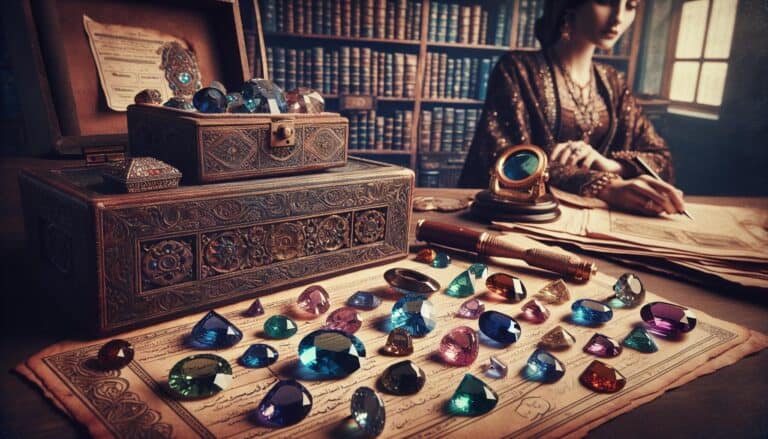Ever wondered what those mesmerizing, crystal-lined rocks you’ve seen at gem shows or in boutique shops might be worth?
Geodes, with their unassuming exterior and breathtaking interior, are nature’s treasure chests, and their value can be just as surprising.
You’re not alone in your curiosity; the worth of geodes sparks the interest of collectors and enthusiasts alike. Factors like size, color, crystal formation, and rarity play crucial roles in determining their price.
Let’s crack open the mystery and discover what factors contribute to a geode’s value.
Whether you’re a seasoned collector or just stumbled upon your first geode, you’re about to find out how much these natural wonders might cost you.
Geode value depends on color, clarity, crystal formation, and rarity. Factors like size, mineral content, and market demand also influence worth. Rare geodes with unique formations or vibrant colors typically command higher prices. When buying, consider authenticity and professional appraisal for true worth.
What Is Geodes?
Geodes are geological rock formations that occur in sedimentary and certain volcanic rocks. They’re essentially hollow, spherical to oblate masses of mineral matter that form in the spaces within rock. When you stumble upon a geode, from the outside, it may look like an unremarkable, rounded rock. However, it’s what on the inside that counts.
Typically, inside a geode, you’ll find a crystalline interior lined with a layer of minerals like quartz, amethyst, or calcite. The interior might just sparkle with crystals developed from mineral-rich water seeping into the cavity and gradually depositing a lining of minerals over thousands, or even millions, of years.
Discovering the contents of a geode is an adventure in itself. Cracking one open reveals the true beauty hidden within its unassuming exterior. The quality, color, and shape of the crystals are what makes each geode unique, influencing its worth and desirability among collectors.
Geodes can range vastly in size – from as small as a pea to as large as several feet in diameter. Size does have an impact on value, so bigger isn’t always better, but it can be an indicator of a potentially higher price tag.
People often wonder where geodes come from. They’re found in various locations around the globe, with famous deposits in Brazil, Mexico, and the United States, particularly in the deserts of the southwestern states and the volcanically active regions. Their origin can provide a backstory that adds to their allure.
Remember, not all geodes are created equal. The value varies significantly depending on the specific characteristics of each specimen. As a collector or enthusiast, your quest for geodes might be for their aesthetic appeal, their scientific interest, or the thrill of finding and opening them to discover the hidden treasures they contain. As you delve deeper into the world of geodes, the knowledge of their formation and the factors that affect their value will guide your pursuit.
Geodes Prices: Factors That Affect Value

When you’re looking to determine the value of geodes, it’s crucial to consider several factors that can significantly influence their price. Just like diamonds, geodes are appraised based on characteristics such as color, clarity, and quality. Additionally, market demand and the rarity of certain types of geodes can make prices fluctuate unexpectedly. By understanding these elements, you’ll gain insight into what makes some geodes more precious than others.
Color, Clarity, and Cut Quality
Geodes come in a broad spectrum of colors, ranging from deep purples to vibrant blues or even clear quartz. The more intense and unusual the color, the greater the value tends to be.
- Color: Vivid and unique colors typically increase a geode’s worth.
- Clarity: Geodes that have transparent or translucent crystals are often more valuable than those with opaque interiors.
- Cut Quality: The way a geode is cut can enhance the display of its crystalline structure, thereby affecting its overall appeal and value.
Remember, the more aesthetically pleasing the combination of these factors, the higher the price a geode may fetch on the market.
Market Demand and Availability
Your ability to fetch a high price for geodes also depends on current market trends and the availability of similar specimens. Geodes that are in high demand but low in supply will usually sell for more. Conversely, if the market is flooded with geodes of a particular type, even high-quality specimens might not command premium prices.
- Market Demand: Trends can be fickle; what’s sought after today might lose popularity tomorrow.
- Availability: Rare geodes from specific locations can garner high prices due to their scarcity.
Understanding the market dynamics and the rarity of the geode you possess will help you better estimate its value. Keep in mind that these factors can change, so staying informed about current trends in geode collecting is key to maximizing your potential return.
Understanding Geodes: A Rare Gem

The Rarity of Geodes
When you’re scoping out geodes for your collection, you’ll often hear the term “rare,” but what does that really mean? Geodes are rare, not just because they’re stunning to look at, but because they form under specific conditions over millions of years. Most geodes are found in deserts or volcanic ash beds, and their locations are usually well-guarded secrets among collectors and enthusiasts.
Nature doesn’t mass-produce these beauties; each geode is a unique occurrence. Their formation begins with gas bubbles in lava or animal burrows, tree roots, and other cavities in sedimentary rock. Over time, these cavities fill with minerals like quartz and calcite, eventually crystallizing to form the inner beauty that’s hidden until you crack them open.
Finding them isn’t a walk in the park either. It requires knowledge, patience, and often a bit of luck. If you manage to stumble upon one, you’ve found something that’s as uncommon as it is beautiful. Few geodes are alike, and their distinctive appeal further enhances their rarity.
Origins and Characteristics
Digging a bit deeper, you’ll find the origins of geodes can tell a tale as old as time. They’re primarily found in volcanic and sedimentary rock formations, where they’ve been maturing for aeons. Places like Brazil, Madagascar, and Mexico are known for their geode deposits, with each location offering different types of geodes. This geographical variance contributes to the myriad of characteristics, distinguishing one geode from another.
Each geode holds within it a distinct pattern and type of crystals. The most commonly known interiors are amethyst, quartz, and celestite. These crystal linings can vary in:
- Color
- Crystal size
- Crystal formation
The value is significantly influenced by these factors—brighter colors and larger crystals typically fetch higher prices. But it’s not just about aesthetics; geodes can also have scientific importance. They often help in understanding the geological history of their surroundings, and they’re used in educational settings to illustrate natural processes.
Geodes aren’t just rocks; they’re nature’s treasure troves, full of mystery and history. Each one is a snapshot in time, waiting for the right moment to reveal its hidden wonders.
Geodes Grading and Valuation
The Grading System for Geodes
When you’re looking to determine the value of geodes, understanding the grading system is crucial. Like diamonds, geodes are assessed based on several factors. These factors include size, color, crystal formation, and overall aesthetic appeal. Smaller geoids might not be worth much, but larger specimens with rare or vibrant hues can fetch a higher price.
Size is considered first; larger geodes naturally tend to be more valuable due to their rarity and potential for more impressive crystal formations inside. When it comes to color, some are more sought after than others; for example, amethyst geodes featuring deep purple tones are particularly prized. Crystal formation matters too; the more uniform and well-developed the crystals, the higher the grade and potential value.
Clarity is another aspect to consider. Geodes with transparent crystals are often more desirable than those with opaque or cloudy formations. While the grading of geodes isn’t standardized like that of gemstones, these criteria serve as a reliable guide for enthusiasts and collectors alike.
Certification and Appraisal
For high-quality geodes, it’s often recommended to seek a professional appraisal. A certified geologist or gemologist can provide you with a more accurate assessment of your geode’s value. This professional evaluation typically includes an analysis of the geode’s physical properties and may also offer insights into its geographical origins.
The certification process often involves a close examination under magnification to detail the quality and condition of the crystals. Documenting the geode’s characteristics through certification can not only give you a better sense of its worth but can also increase its resale value, especially if you’re considering the market for collectibles.
An appraisal report from a recognized authority provides credibility and can come in handy if you’re considering insurance for your geode. It’s worth mentioning that while having your geode certified and appraised can add to its value, it’s also an additional cost to consider. However, for exceptional pieces, this step is a valuable part of the investment in your collection.
Current Market Trends in Geodes Pricing
In the world of collectible rocks and minerals, geodes consistently capture the imagination of collectors and enthusiasts. As you dive into the pricing trends, it’s crucial to understand that market demand significantly influences geode prices. Recently, an uptick in home decor featuring natural elements has contributed to a surge in popularity for geodes. This crossover appeal not only boosts their visibility but also their perceived value.
Understanding global trends is vital. For example, Amethyst geodes have seen a steady increase in value, due to their deep purple color, which is highly sought after. The rarity of certain colors and crystal clarity can cause prices to fluctuate. When large-scale events, like international gem expos, take place, exposure to rare specimens often results in a temporary spike in market prices.
Another factor to consider is the current trend towards organic and eco-friendly products. Geodes, being natural formations, fit perfectly within this niche. The younger demographic, with their growing purchasing power and interest in sustainable products, is increasingly drawn to geodes, bolstering market prices.
Let’s look at some recent market data on geodes:
| Size | Average Price Range |
|---|---|
| Small (1″-3″) | $10 – $50 |
| Medium (4″-7″) | $50 – $150 |
| Large (8″+) | $150 – $500+ |
Keep in mind that these are average prices and exceptional pieces can fetch significantly higher amounts. Rarer geodes with perfect crystal formation or unique features can garner thousands of dollars.
As a savvy collector, it’s also wise to keep an eye on online auctions and digital marketplaces. They often provide a real-time snapshot of what collectors are currently paying for geodes. This digital footprint offers invaluable insight into the latest trends, especially for those you’re looking to buy or sell in the near future.
Remember, while larger and more aesthetically pleasing geodes tend to carry a higher price tag, ultimately, the worth of a geode is determined by what a buyer is willing to pay. Monitoring the market and staying informed on current trends is the best way to estimate the value of your geodes, regardless of whether you’re adding to your collection or considering a sale.
The Most Expensive Geodes
When you’re exploring the world of geodes, you’ll quickly discover that some specimens stand out in terms of value. These aren’t your average, run-of-the-mill rocks; they are true natural wonders that fetch stunning prices at auctions and in private sales.
So, what makes a geode exceptionally expensive? Rarity and aesthetics play a crucial role. Amethyst geodes, known for their striking purple crystals, often command higher prices, especially when they display a deep, saturated hue and large crystal formations. In contrast, Celestite geodes, cherished for their sky-blue crystals, can also reach substantial sums due to their soothing color and relative scarcity.
Unearthing a geode that is both large and contains rare crystals like black quartz or blue agate can result in prices that soar into the tens of thousands of dollars. For instance, a significant amethyst geode dubbed the ‘Empress of Uruguay’ stands tall at 11 feet and is valued at over $75,000.
The following table illustrates the price range of some of the priciest geodes known:
| Type | Size Range | Price Range |
|---|---|---|
| Amethyst Geodes | Over 3 feet | $2,000 to $25,000+ |
| Celestite Geodes | 1-2 feet | $500 to $5,000+ |
| Rare Crystal Geodes | Varies | $5,000 to $100,000+ |
Astute collectors understand that provenance can also significantly affect a geode’s price. A geode’s history, especially if linked to a famous locality or a notable previous owner, can increase its allure and monetary value.
Still, it’s not just about rarity and backstory. A geode’s internal beauty, reflected in the quality of the crystal formations and the impact of its aesthetic display, can elevate a pretty stone to a breathtaking work of art that’s worth every penny. As you delve deeper into the geode market, keep in mind that the most sought-after pieces are a blend of size, remarkable crystals, and a story that adds to their uniqueness.
Buying Geodes: Tips and Recommendations
When you’re in the market for geodes, whether it’s for personal collection, educational purposes, or home decor, knowing where to find high-quality specimens and how to ensure their authenticity is crucial. In this section, you’ll gain insights into making the best purchases.
Where to Purchase High-Quality Geodes
Finding the perfect geode requires some knowledge of reputable sources. Rock shops, mineral shows, and online marketplaces are common starting points for enthusiasts and collectors alike.
- Rock and Mineral Shows: These events are ideal for seeing a variety of geodes in person. Vendors are typically passionate about their collections and can provide you with valuable information.
- Specialized Rock Shops: Local rock shops often carry a selection of geodes. The advantage of these is the ability to see the geode before buying and to build relationships with knowledgeable sellers.
- Online Marketplaces: Websites such as eBay and Etsy offer a wide range of geodes. When shopping online, be sure to check the seller’s ratings and read customer reviews.
Keep in mind that you can often negotiate prices at shows and shops, especially if you’re buying in bulk.
Ensuring Authenticity and Value
Guaranteeing that your geode is the real deal and worth your investment involves a few prudent steps:
- Ask for Documentation: If the geode is claimed to be valuable, ask for any certificates or appraisals that attest to its quality.
- Examine the Geode: Look for signs of dye or artificial enhancements. Natural geodes should have imperfections and variations in color.
- Consult with Experts: If possible, bring a geologist or experienced collector with you when making a significant purchase to help determine the geode’s authenticity.
- Research the Seller: Ensure that sellers have a good reputation in the community and a history of positive transactions.
By following these tips, you can make informed decisions and invite the tranquil beauty of geodes into your life with confidence.
Conclusion: Buying & Selling Geodes
You’ve now got the knowledge to navigate the geode market like a pro. Remember to prioritize authenticity and quality over size and flashiness.
Whether you’re adding to your collection or starting anew, the true worth of geodes goes beyond their price tag. It’s the satisfaction and pride in owning a natural wonder that’s been millions of years in the making.
So go ahead, make that informed purchase and let the natural beauty of geodes enrich your space and your spirit.


![South Dakota Rockhounding Sites in [year]](https://observationhobbies.com/wp-content/uploads/2024/01/kNC8Njq0n49hZutA6mi-768x439.jpg)

![NJ Rockhounding Sites in [year]: Locations & Treasures](https://observationhobbies.com/wp-content/uploads/2024/01/ugMmbaQ3jtMbGgQd582Om-768x439.jpg)

![Illinois Rockhounding Sites in [year]: Best Spots & Finds](https://observationhobbies.com/wp-content/uploads/2024/01/bD90IrQO6PXFhraASvW2C-768x439.jpg)
